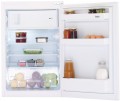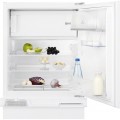Total capacity
The total volume of a refrigerator is the sum of the volumes of all its compartments, which can vary in specific capacity between different models. It's important to consider this when choosing a refrigerator.
A larger volume for a refrigerator can be beneficial for accommodating more food, but it can also increase the price and size of the appliance. This is especially important to consider if you plan to build the refrigerator into a specific space.
Number of shelves
The amount of shelves in a refrigerator determines the division of space within the refrigeration compartment. Larger refrigeration compartments generally have more shelves, but there are also various configurations available even within the same volume (
3 shelves,
4 shelves,
5 shelves and more). It is worth considering that they are mostly removable, which allows you to adjust the height of the shelf. And if necessary, you can buy more.
Freezer capacity
The primary function of the freezer is to store food in a state of deep freeze, which helps preserve perishable products such as meat, vegetables, fruits, etc. for extended periods of time. The necessary volume of the freezer depends on the planned amount of food to be stored and the length of time it will be stored. A larger freezer is particularly useful if you plan to store food for several months.
A compact freezer is relevant for short-term storage (for a day or two) or for seasonal devices (for example, in the village). It is best to ensure that the freezer is not overloaded and has enough space for proper circulation of air to maintain the desired temperature.
Freezer temperature
The lowest temperature provided by a refrigerator freezer.
The lower the freezer temperature indicator, the more advanced the freezer is considered to be, and the better it is suited for long-term food storage with wider capabilities. It's important to note that the standard operating temperature for a fully functional freezer is -18 °C, which is suitable for both storing and freezing pre-frozen foods. Some refrigerators are designed with a temperature indicator of -24 °C, but this is mainly achieved through the quick freezing mode (see "Functions"), and the standard operating temperature is still -18 °C. However, if you plan to freeze food frequently and store it for extended periods, it's better to choose a model with a temperature of -24 °C and consider the freezing power as well.
Less expensive refrigerators have a less advanced freezer with a modest minimum temperature of -12°C or even -6°C, which is only suitable for storing pre-frozen foods, not for freezing fresh food. Although they are much more affordable.
To indicate the temperature of the freezer, markings in the form of asterisks (snowflakes) are often used, each of which means a decrease in temperature by 6 °C. For example, the mentioned -18 °C will correspond to 3 asterisks (***).
Autonomy time
Refrigerators with good thermal insulation can maintain low temperatures inside for a significant amount of time even if there is a power outage. This period of time is known as the "keep cold time," during which the refrigerator can preserve perishable food items. A longer keep cold time indicates better thermal insulation, making the refrigerator more suitable for areas where power outages are common.
Freeze capacity
The freezing capacity of a refrigerator refers to the amount of fresh food it can freeze from room temperature to the freezer temperature within a 24-hour period. For everyday use, a freezing capacity of up to 10 kg/day is sufficient, but if you frequently freeze large volumes of food, you should consider a more
powerful freezer.
Energy class
The energy class that the refrigerator corresponds to.
Energy consumption classes were originally designated with Latin letters from
A (the most efficient) to D (least efficient), but with technological advancements, more advanced classes such as "A+", "A++", etc. were introduced to indicate increasing levels of efficiency. The more pluses a device has, the more economical it is. This was necessary due to the correlation between energy consumption and decreasing efficiency.
For modern built-in refrigerators, the efficiency indicator at the level of class A can be called average,
A+ — not bad,
A++ — good,
A+++ — excellent. Energy consumption rates B and C are rare and mostly found in outdated or cheaper models. Achieving high efficiency requires design innovations, which results in higher device prices. However, these prices can be justified by the resulting reduction in electricity bills. It's worth noting that some built-in refrigerator models are available in different energy consumption classes, allowing customers to choose the best option for their budget and energy efficiency needs.
Energy consumption per year
The average amount of energy consumed by a refrigerator in a year of operation.
The given parameter is an estimated value and assumes that the refrigerator operates under stable conditions without sudden temperature changes, frequent door openings, and within its designated climate class (see below). Actual energy consumption may deviate slightly from the stated value. Despite this, it is a useful parameter that allows for a rough comparison of different models in terms of energy efficiency.
It should be noted that the energy consumption per year is often a more practical and convenient parameter than the energy consumption class (see above), which is a relative indicator of how efficient a refrigerator is compared to other models of similar size and features. The energy consumption per year, on the other hand, provides an estimate of the actual electricity cost when using a particular refrigerator. For instance, a small two-door refrigerator with an energy class of A can consume less energy per year than a large side-by-side refrigerator with a class of A+++, despite the fact that the latter is formally more energy-efficient than the former in terms of its energy class.
Climate class
This parameter describes the climate conditions for which a particular refrigerator model is designed. A more powerful cooling system and better thermal insulation are required for the refrigerator to operate efficiently in hot conditions compared to low air temperatures. If the refrigerator is not designed for the specific climate conditions it operates in, it may not function efficiently or may even fail.
—
SN (subnormal).Refrigerators of this class are intended for use in temperate climates with relatively low temperatures. They are designed to operate within a temperature range of +10°C to +32°C, which is slightly lower than class N. These refrigerators can be particularly useful in poorly insulated rooms where the temperature can drop below +16°C during the colder seasons.
—
N (normal). Models designed for moderate climate, with ambient temperature from +16 °C to +32 °C.
—
ST (subtropical). Although named after subtropical climates, these models are suitable for both subtropical and tropical climates with high humidity. They can operate within a temperature range of +18°C ... +38°C.
—
T (tropical). Units designed primarily for dry tropical climates. They operate at ambient temperatures from +18 °C to +43 °C.
to the development of refrigerators with combined climate classes and enhanc
...ed features. These models are characterized by both upper and lower classes, such as N-ST, indicating a wider operating range from the lower limit of the lower class to the upper limit of the upper one. For instance, N-ST corresponds to a temperature range of +16...+38 °C. Some models even combine all four classes, such as SN-T, which has an extended range of +10...+43 °C.
With climate change affecting many regions, the introduction of combined climate classes has become increasingly important. In some areas classified as temperate, summers have become hotter while winters remain cold, and a single climate class such as N may not provide adequate coverage for the required temperature range.
